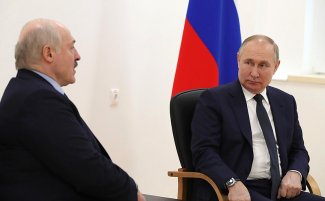The price of dependence on Russia. The economic consequences of Belarus’s complicity in Russia’s aggression against Ukraine

In Q1 2022, Belarus’s GDP contracted by 0.4% – the first GDP decline since the end of 2020. Being Russia’s closest military ally, Belarus has made its territory available to the Russian Armed Forces, thereby joining Russia’s invasion of Ukraine, which resulted in it being targeted by Western sanctions. The sanctions imposed in March 2022, mainly those covering the export of timber, as well as wood, metal and steel products, have not only upheld but also expanded previous sanction packages introduced in response to the Lukashenko regime suppressing the street protests following the rigged presidential election held in 2020. As a consequence, under increasing isolation by the West in recent weeks, Minsk has lost almost all of its most profitable export categories to both EU member states and Ukraine. Moreover, Belarus’s present situation is prompting foreign investors and Belarusian companies’ business partners, which continue to operate there, to leave the Belarusian market. At present, Belarus is unable to refinance its foreign debt, which has not only resulted in a decline in foreign currency reserves, but also exacerbated solvency problems. The introduced mitigation measures are provisional and the only external source of support Belarus can count on is Russia, which itself has been affected by tough sanctions and therefore is reluctant to provide the assistance Minsk needs. As a consequence, 2022 will most likely see a profound recession in the Belarusian economy: the country’s GDP may shrink by as much as 6% or even 15%.
A slump in exports
The 3.3%-decline in GDP recorded in March 2022 has marked the end of the positive growth trend present in the Belarusian economy since the beginning of 2021. Although the foreign trade statistics for Q1 2022 have not yet been published, it is almost certain that a major decline in Belarus’s exports has begun. Throughout 2022, the crisis in trade exchange will translate into a significant aggravation of the trade deficit. The magnitude of Belarus’s trade deficit will most likely exceed that recorded not only in 2021 but also in several previous years, made all the worse in this respect given that the country’s trade deficit ranged from US$2–4 billion during this period.
On 1 February – due to sanctions imposed by the US – Lithuania introduced a transit blockade of Belarusian-made potash fertilisers bound for the Klaipeda seaport, thereby closing the main export route for one of Belarus’s key categories of commodities.[1] As a consequence, foreign trade figures for February 2022 were significantly lower than those for January 2022. However, it was the package of economic sanctions imposed by the EU on 2 March that had the most devastating effect on Belarusian exports. These sanctions covered the most profitable categories of goods: in 2021 their sale to the EU generated a 74% increase in export revenue (up to US$9.5 billion) and accounted for a quarter of Belarus’s total exports. The estimated value of the commodities covered by the sanctions is at least US$5.6 billion (around 9% of Belarus’s GDP). Combined with the value of other goods (including fuels), whose export had been blocked by previous sanctions, this figure amounts to around 70% of Belarus’s exports to the EU to date. This de facto equates to an almost complete collapse in Belarus’s exports to the EU.[2] It should be noted that, until recently, Minsk earned a considerable profit from the export of goods to Ukraine and to EU member states, which in turn enabled it to offset the deficit in its trade balance that mainly resulted from its trade with Russia and China.
Transport, fuel and potassium sectors recording negative figures
Another blow delivered to Belarus’s exports was the EU sanction package introduced on 8 April 2022, which included a ban on Belarusian road carriers entering the EU, including for transit. For Belarus, which is a transit country with huge logistical and transport infrastructure (including a large fleet of trucks owned by both state-controlled and private companies), this is a painful restriction regardless of numerous embargo exemptions.[3] In 2021, largely due to Belarus’s access to the EU market, the road transport sector generated profits to the tune of around US$2 billion, i.e. around 3% of the country’s GDP. This figure accounted for 20% of total revenue generated by the Belarusian export of services, which has thus far been an important and – it should be emphasised – a stable source of revenue.[4]
It was only in January 2022 that the EU and US embargoes on the export of fuels and potash fertilisers, introduced in the second half of 2021, began to translate into a decline in the petrochemical sector. In March 2022, the Belaruskaliy potassium company, which until recently generated a stable revenue (in recent years it ranged between US$2.5 billion and US$3 billion annually), suspended production at three of its five mining fields and, for the first time, asked the state for a loan to cover its current salary payments.[5] However, in April 2022, reports emerged that all production has temporarily been suspended and the need to carry out modernisation works was cited as the official reason. Lithuania blocking the transit of Belarusian fertilisers translated into delays in concluding contracts with major importers: China, India and Brazil (so far, only information suggesting that a new contract was signed with Beijing has been forthcoming). As a consequence, the Belarusian authorities have begun to seek other export routes. In February 2022, they probed the possibility of using Russian harbours (in St. Petersburg and Murmansk) and Russian railways to transport the fertilisers to China and India. Lukashenka, for his part, went on to promote the idea of building a new potassium terminal in Leningrad Oblast, allegedly having received the relevant approval from the Russian government.[6] However, it is unlikely that such a large infrastructural investment will be carried out within the next few months – a timeframe of several years seems more likely, especially as no confirmed information regarding the initiative’s commencement has been revealed thus far.
The Belarusian oil refining industry, which alongside the potassium sector is of crucial importance to the country’s export revenue, has also been affected by problems. In Q1 2022, Belarus’s two refineries, located in Novopolotsk and Mozyr, have halved their daily throughput (compared to the corresponding period in 2021), and their production is being sold exclusively on the much less profitable domestic market.[7] The revenue from the sale of Belarusian fuels on foreign markets ranged between US$3 billion and US$6 billion annually, depending on the price level. Lukashenka’s support for the Russian aggression has resulted in a halt in Belarus’s exports to Ukraine, its second largest trade partner (after Russia), which until recently accounted for more than 13% of its foreign trade. Fuels, which accounted for almost 60% of Belarus’s exports to the Ukrainian market and in 2021 were worth US$2.9 billion, were a particularly important export category. It cannot be ruled out that the export of this strategic commodity was suspended under pressure from Russia. Potash fertilisers – another important commodity exported to Ukraine – are also worth mentioning. In 2021, potash fertilisers worth almost US$600 million were sold to Ukraine. The collapse of trade with Ukraine will significantly aggravate Belarus’s trade deficit. This is highly likely, because for many years Minsk had a considerable surplus in its trade exchange with Kyiv. In 2021, this surplus amounted to US$3 billion.[8]
The toxic economy syndrome
The increasingly tough Western sanction regime has further weakened the credibility of the Belarusian authorities on international financial markets. This is evidenced, among other things, by the decline in foreign exchange reserves, which in February and March 2022 declined by a total of US$1 billion, to US$7.5 billion. This is the largest drop in reserves since August 2020, when Minsk’s relations with the West collapsed. One of the reasons why the scale of this decrease was so large is the fact that Belarus applied a preventive measure involving the transfer of funds from the central bank’s resources in order to avoid their potential freezing under Western financial sanctions similar to those applied to Russian currency reserves. In addition, the financial regulator admitted to having been forced to intervene on the domestic market due to increased demand for foreign currencies on the part of Belarusian citizens. In March 2022, they withdrew US$270 million from Belarussian banks, which is a record amount compared to previous years. This indicates that Belarusian citizens’ confidence in the national currency and in the domestic banking system is extremely low.[9] In this context, a continued rise in the inflation rate, which in March 2022 stood at almost 16% (compared to just below 10% in February 2022), is only to be expected.
Servicing its foreign debt denominated in euros and dollars is becoming a major challenge for Belarus. As early as December 2021, the Belarusian authorities publicly admitted that they were having difficulties servicing this debt.[10] The problems are aggravated by the fact that, partly due to restrictions imposed on Russia, three large state-controlled banks (Development Bank of the Republic of Belarus, Belagroprombank and Bank Dabrabyt), as well as Belarusian branches of Russian banks, have been disconnected from the SWIFT payment system. At the same time, it cannot be ruled out that under new sanction packages other financial institutions will be disconnected from this system as well. This is why in April 2022, following a similar decision taken by Moscow, Minsk announced its intention to repay a portion of its debt using Belarusian roubles. This solution has mainly been applied to the repayment of debt Belarus owes to the European Bank for Reconstruction and Development, the Nordic Investment Bank, the International Bank for Reconstruction and Development (a World Bank body), as well as to states that the Belarusian authorities consider unfriendly, which comprises all EU member states and 12 other countries (including the US). Although in this year’s repayment schedule the sums owed to these creditors account for a mere 7% of all liabilities due by the end of 2022 (US$2.8 billion in total), the very fact that Minsk unilaterally decided to switch to Belarusian roubles may be considered proof of Belarus’s technical default. As a consequence, Belarus’s access to new loans may be blocked (even before the war Belarus was de facto unable to refinance its debt in the West) and its assets abroad (e.g. batches of exported goods) may be confiscated as part of the enforcement of court decisions in lawsuits brought by creditors.[11] In this context, the decision of the world’s three biggest financial rating agencies (Moody’s, Fitch and S&P) to downgrade Belarus’s credit ratings to CCC, which is indicative of serious solvency problems, is understandable.
Due to Lukashenka’s complicity in Russia’s aggression against Ukraine, a portion of foreign companies operating on the Belarusian and the Russian markets have suspended their activities (including the furniture and household goods retail chain JYSK, IKEA, the American microchip manufacturer Intel, H&M, Booking.com, American Express, Airbnb, the Danish logistics company Maersk, the German truck manufacturer MAN and the delivery companies UPS and DHL).[12] The Finnish company Olvi, which produces beer and non-alcoholic beverages in Lida, and the Lithuanian furniture producer SBA, which until recently owned a manufacturing plant in Mogilev, decided to withdraw from the Belarusian market completely.[13] Investors that own large industrial plants and consumer service networks adopted a slightly more conservative approach. These include the Austrian mobile network operator A1, the Kronospan company producing floor panels, chipboard and other wood products, and the Swiss producer of railway carriages and locomotives Stadler Rail. They continue to operate, although they already have reported difficulties with importing the necessary components and maintaining financial liquidity; some of them have decided to lay off a portion of their staff.[14] Problems related to supply chain disruptions, severed cooperation with foreign partners and financial settlement difficulties are affecting both companies with foreign headquarters and Belarusian companies (in sectors such as machine building, electronics, production of household appliances), which increasingly frequently are forced to reduce or suspend their production activities.[15]
The end of the Belarusian ‘Silicon Valley’?
The mounting crisis in the Belarusian IT sector, which in 2021 generated 29% of the total value of Belarus’s export of services (5% of GDP), is another issue worthy of note. Due to pressure from Western contractors, who make further cooperation conditional on relocation of their Belarusian business partners, since the end of February 2022 emigration of IT specialists from Belarus (which had begun in 2020 following the wave of repression launched after the presidential election) has accelerated significantly. Belarusian programmers seek job opportunities mainly in Poland, Lithuania and Georgia. These countries are not necessarily their ultimate destinations; frequently these are transit countries in which the emigrants can obtain visas to EU member states faster than in those countries’ diplomatic posts in Belarus, as these have recently been reduced. The exodus of IT specialists is evident not only in small companies with just a few employees, but also in large businesses such as EPAM or Wargaming. In an online survey covering 3,000 programmers conducted by the IT industry portal dev.by, as many as 30% of the respondents admitted that they had left the country and another 30% expressed their intention to emigrate in the nearest future. As a consequence, in the next couple of months, up to 60,000 citizens with a degree in IT may leave Belarus.[16] Another likely group of emigrants, which at this point is difficult to estimate, includes men evading conscription and individuals seeking job opportunities in the EU. Almost 70,000 Belarusian citizens have found employment in Poland alone (according to data compiled by the Polish Social Insurance Institution [ZUS] as at the end of 2021).[17]
Chaos and desperation – proposed remedies
Minsk has taken a number of steps to at least partially mitigate the consequences of the looming crisis and to punish specific countries and individual foreign investors for opposing the regime’s policy. One of these steps involved the authorities turning to Belarus’s ally, i.e. Russia, for economic support. This resulted in the two states agreeing on 14 March 2022 to abandon the US dollar and switch to the Russian rouble in settlements for the supplies of fuels. In addition, a series of decisions was made regarding the servicing of Belarus’s debt to Russia (the amount due in 2022 is more than US$ 1 billion, or around 30% of the total debt). It should be noted that Russia agreed to Minsk deferring its debt repayments for five to six years.[18] These modifications are intended to postpone the threat of a total collapse of Belarusian public finances and should be viewed as a concession from Russia in exchange for Belarus’s loyalty. However, Belarus is seeking even greater support, including access to the Russian railway infrastructure to enable the transit of potash fertilisers, alongside genuine facilitation regarding its exports to Russia, particularly in those market segments which have been affected by Western restrictions (e.g. the machine-building and electronic sectors). According to the Belarusian government, these measures could result in a 30% increase in the country’s exports to the Russian market.[19] However, for the time being there are no indications that Russia, which is shouldering the burden of unprecedented sanctions, would be ready to offer such far-reaching preferences to Belarus, especially as the capacity of the Russian transport infrastructure has already been severely limited. Moreover, in those sectors of the economy which are of key importance to Minsk (e.g. the fuel and potassium sectors) Russia and Belarus are global market competitors.
In its domestic economic policy, the Belarusian regime resorted to instruments typical of an authoritarian state with a centrally planned economy. Temporary export restrictions have been introduced on over 200 categories of goods, including basic foodstuffs such as salt, sugar, buckwheat and wheat flour. Alongside this, administrative price controls covering certain necessities have been introduced. In the IT and advertising sectors, which continue to be profitable, taxes have been raised, which these sectors’ employees will most likely view as an additional emigration impetus. In addition, the Belarusian authorities are seeking additional sources of foreign currencies. This is why – quite unexpectedly and against the political logic – Minsk has decided to lift the visa regime for the citizens of Lithuania and Latvia for one month starting from 15 April 2022. It seems that the regime’s principal motivation was to facilitate travel for residents of the Lithuanian and Latvian borderlands, who frequently make shopping trips to Belarus (to buy such things as petrol, tobacco and alcohol), and to encourage them to sell euros in Belarusian exchange offices. In addition, the government has introduced additional fees for foreign investors intending to withdraw from the Belarusian market, and the Finance Ministry has announced that it may block attempts by companies with foreign capital to relocate or close their businesses. These restrictions are expected to remain in place at least until the end of 2022.[20]
Minsk has been making attempts to circumvent the sanctions introduced after 24 February or to mitigate their impact. On 13 April 2022, the media reported on a proposal by the Association of Freight Forwarders and Carriers involving a new model of cooperation, put forward in response to Belarusian transport companies being banned from entering the European Union. According to the proposal, EU-registered vehicles would be allowed to enter Belarus to take or drop off cargo which would then be picked up or delivered to end customers by companies operating in Belarus. It seems that these suggestions have been taken into account in Minsk’s counter-sanctions banning EU carriers from entering Belarus starting from 16 April 2022; it should be noted, however, that this ban does not cover the 14 designated logistical centres on the Belarusian side of the border.[21] Thereby, Minsk not only seeks to undermine the effectiveness of the sanctions, but also intends to boost its own profits by making sure that the most profitable logistical operations are carried out on Belarusian soil.
A profound recession is inevitable
Belarus’s complicity in the Russian aggression against Ukraine, resulting from its political dependence on and its close military alliance with Russia, has considerably aggravated the situation of the Belarusian economy. The dynamic increase in exports, recorded last year, was a short-term phenomenon mainly triggered by the post-pandemic rebound on foreign markets, and could not be sustained in the long term. The beginning of 2022 saw a further decline resulting from EU and US embargoes on the export of fuels and potash fertilisers, and the introduction of new sanction regimes. Accustomed to using administrative methods to manage the economy and at the same time unable to resume dialogue with the West (because this would require, among other things, the withdrawal of Russian troops from Belarus and the release of all political prisoners), the authorities in Minsk will be unable to balance the huge financial losses resulting not only from the collapse of Belarus’s exports to the EU, but also from the fact that Belarus has lost – for many months (or perhaps even years) – access to the equally important Ukrainian market. The government’s announcements regarding multiple opportunities for diversification in foreign trade and for an almost unlimited support from Russia do not match reality. The situation is further aggravated by the government’s chaotic and ad hoc crisis mitigation policy which de facto reveals its helplessness in the face of unprecedented economic problems. As a result, the decline in GDP, which was already evident in the March 2022 statistics, will continue to gain momentum and the only factor that remains unknown is the magnitude of the recession. The World Bank, which is conservative in its assessments, forecasts a 6.5% contraction of the Belarusian GDP in 2022. However, it cannot be ruled out that a much more pessimistic outlook by the influential S&P rating agency, suggesting a decline of as much as 15%, will materialise.
[1] A. Кирейшин, ‘Внешняя торговля Беларуси. Есть ли повод для оптимизма?’, Белорусы и рынок, 9 April 2022, belmarket.by.
[2] K. Kłysiński, ‘Belarus: new EU sanctions for its participation in the war against Ukraine’, OSW, 4 March 2022, osw.waw.pl.
[3] These exemptions were introduced on the basis of decisions made by specific EU member states and include the transport of certain categories of goods such as pharmaceutical and medical products, foodstuffs and agricultural produce, and goods dispatched to diplomatic posts and for humanitarian purposes.
[4] M. Menkiszak, cooperation K. Kłysiński, ‘Szczegóły piątego pakietu sankcji UE’, OSW, 9 April 2022, osw.waw.pl.
[5] ‘Три из пяти рудоуправлений в Солигорске остановились, «Беларуськалий» впервые берет кредиты на зарплаты’, Наша Ніва, 21 March 2022, nashaniva.com.
[6] K. Kłysiński, ‘The end of prosperity? The West blocks the export of Belarusian potash fertilisers’, OSW, 7 February 2022, osw.waw.pl.
[7] ‘Белорусские НПЗ из-за санкций работают на внутренний рынок’, Наша Ніва, 19 April 2022, nashaniva.com.
[8] ‘«На торговле с Киевом будет поставлен крест». Сколько Беларусь потеряет от войны в Украине’, Белсат, 8 March 2022, belsat.eu/ru.
[9] ‘Золотовалютные резервы Беларуси в марте: причины сильнейшего падения за 1,5 года’, Экономическая Газета, 11 April 2022, neg.by.
[10] ‘Снопков — о проблемах с госдолгом из-за санкций, блокировке денег западными банками и планах по кредитам’, Зеркало, 16 December 2021, zerkalo.io.
[11] A. Богуславская, ‘Беларусь хочет платить рублями по внешнему долгу: почему это дефолт’, Deutsche Welle, 11 April 2022, dw.com/ru.
[12] В. Беляев, ‘Какие бренды покидают Беларусь’, 7 March 2022, thinktanks.by.
[13] А. Свиридович, ‘Уходящие и остающиеся. Топ-15 крупнейших западных работодателей в Беларуси’, Белорусы и рынок, 29 March 2022, belmarket.by.
[14] ‘Швейцарская компания Stadler не уйдет из Беларуси, но из-за санкций сократит штат на 300−400 человек’, Зеркало, 19 March 2022, zerkalo.io.
[15] ‘«С начала войны ни одного заказа». У белорусских компаний начались проблемы с поставками иностранных комплектующих’, Зеркало, 20 April 2022, zerkalo.io.
[16] ‘«Около 70% экспорта в ЕС под санкциями». Что ждет белорусскую экономику’, Наша Ніва, 28 March 2022,
nashaniva.com.
[17] ‘Rośnie liczba obcokrajowców pracujących w Polsce. Coraz więcej Białorusinów’, 10 January 2022, money.pl.
[18] ‘Минск получил у Москвы рассрочку для платежей по кредитам’, Интерфакс, 14 March 2022, interfax.ru.
[19] ‘Министр экономики анонсировал рост экспорта из Беларуси в РФ на 30% и возможное обнуление пошлин на продовольствие в ЕАЭС’, Зеркало, 10 April 2022, zerkalo.io.
[20] ‘В Минфине рассказали, какие преграды будут вводить для иностранных компаний, которые захотят уйти с белорусского рынка’, Зеркало, 18 March 2022, zerkalo.io.
[21] ‘С 21 апреля расширен перечень неподсанкционных грузов для перевозчиков ЕС при въезде в Беларусь’, 21 April 2022, infotrans.by.




